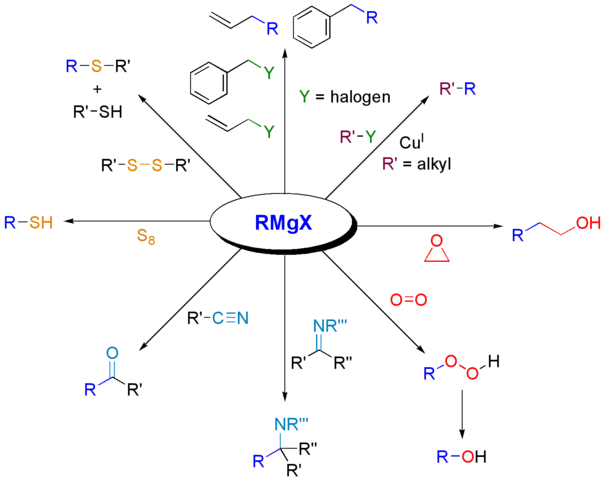The Grignard reaction (French: [ɡʁiɲaʁ]) is an organometallic chemical reaction in which carbon alkyl, allyl, vinyl, or aryl magnesium halides (Grignard reagent) are added to the carbonyl groups of either an aldehyde or ketone.[1][2] This reaction is important for the formation of carbon–carbon bonds.[3][4]
(R2 or R3 could be a hydrogen)
An example of a Grignard reaction

Grignard reactions and reagents were discovered by and are named after the French chemist François Auguste Victor Grignard (University of Nancy, France), who published it in 1900[5] and was awarded the 1912 Nobel Prize in Chemistry for this work.[6] The reaction of an organic halide with magnesium is not a Grignard reaction, but provides a Grignard reagent.[7]

Although Grignard reagents undergo many reactions, the classical Grignard reaction refers only to the reaction of RMgX with ketones and aldehydes, shown in red.
Reaction mechanism
Because carbon is more electronegative than magnesium, the carbon attached to magnesium functions as a nucleophile and attacks the electrophilic carbon atom within the polar bond of a carbonyl group. The addition of the Grignard reagent to the carbonyl group typically proceeds through a six-membered ring transition state.[8]
The mechanism of the Grignard reaction.
Based on detection of radical coupling side products, an alternative single electron transfer (SET) mechanism that involves the initial formation of a ketyl radical intermediate has also been proposed.[9] A recent computational study suggests that the operative mechanism (polar vs. radical) is substrate dependent, with the reduction potential of the carbonyl compound serving as a key parameter.[10]
Other reactions using Grignard reagents
See also: Grignard reagents § Reactions of Grignard reagents
The classical Grignard reaction typically refers only to the reaction between a ketone or aldehyde group and a Grignard reagent to form a primary or tertiary alcohol.[5] However, some chemists understand the definition to mean all reactions of electrophilic molecules with Grignard reagents.[11]
Therefore, there is some dispute about the modern definition of the Grignard reaction.
March's Advanced Organic Chemistry, a reputable graduate level text, defines it as "The addition of Grignard reagents to aldehydes and ketones...".[1] The IUPAC Goldbook, a similarly reputable text, does not address either side.[7] In the Merck Index, published online by the Royal Society of Chemistry, the classical definition is acknowledged, followed by "A more modern interpretation extends the scope of the reaction to include the addition of Grignard reagents to a wide variety of electrophilic substrates."[11]
Shown below are some reactions involving Grignard reagents, but themselves are not classically understood as Grignard reactions.

Reactions of Grignard reagents with various electrophiles
See also
Grignard reagent
Wittig reaction
Horner–Wadsworth–Emmons reaction
Barbier reaction
Bodroux-Chichibabin aldehyde synthesis
Fujimoto-Belleau reaction
Organolithium reagents
Sakurai reaction
Indium mediated allylation
Alkynylation
References
Smith, Michael B.; March, Jerry (2007), Advanced Organic Chemistry: Reactions, Mechanisms, and Structure (6th ed.), New York: Wiley-Interscience, ISBN 978-0-471-72091-1
Chapter 19: Carboxylic Acids. Organic Chemistry 4e Carey. mhhe.com
Shirley, D. A. (1954). "The Synthesis of Ketones from Acid Halides and Organometallic Compounds of Magnesium, Zinc, and Cadmium". Org. React. 8: 28–58.
Huryn, D. M. (1991). "Carbanions of Alkali and Alkaline Earth Cations: (ii) Selectivity of Carbonyl Addition Reactions". In Trost, B. M.; Fleming, I. (eds.). Comprehensive Organic Synthesis, Volume 1: Additions to C—X π-Bonds, Part 1. Elsevier Science. pp. 49–75. doi:10.1016/B978-0-08-052349-1.00002-0. ISBN 978-0-08-052349-1.
texte, Académie des sciences (France) Auteur du (January 1, 1900). "Comptes rendus hebdomadaires des séances de l'Académie des sciences / publiés... par MM. les secrétaires perpétuels". Gallica. Retrieved April 23, 2023.
Grignard, V. (1900). "Sur quelques nouvelles combinaisons organométaliques du magnésium et leur application à des synthèses d'alcools et d'hydrocabures". Compt. Rend. 130: 1322–25.
IUPAC. Compendium of Chemical Terminology, 2nd ed. (the "Gold Book"). Compiled by A. D. McNaught and A. Wilkinson. Blackwell Scientific Publications, Oxford (1997). ISBN 0-9678550-9-8. doi:10.1351/goldbook.
Maruyama, K.; Katagiri, T. (1989). "Mechanism of the Grignard reaction". J. Phys. Org. Chem. 2 (3): 205–213. doi:10.1002/poc.610020303.
Ashby, E. C.; Goel, A. B. (August 1981). "Direct evidence supporting a single electron transfer pathway in the reduction of ketones by primary, secondary, and tertiary Grignard reagents". Journal of the American Chemical Society. 103 (16): 4983–4985. doi:10.1021/ja00406a070. ISSN 0002-7863.
Peltzer, Raphael Mathias; Gauss, Jürgen; Eisenstein, Odile; Cascella, Michele (February 12, 2020). "The Grignard Reaction – Unraveling a Chemical Puzzle". Journal of the American Chemical Society. 142 (6): 2984–2994. doi:10.1021/jacs.9b11829. hdl:10852/83918. ISSN 0002-7863. PMID 31951398. S2CID 210709021.
"Grignard Reaction | The Merck Index Online". www.rsc.org. Retrieved April 23, 2023.
vte
Organometallic chemistry
Principles
Crystal field theory Ligand field theory 18-electron rule d electron count Polyhedral skeletal electron pair theory Isolobal principle π backbonding Dewar–Chatt–Duncanson model Hapticity spin states Agostic interaction Metal–ligand multiple bond
Reactions
Oxidative addition / reductive elimination Migratory insertion β-hydride elimination Transmetalation Carbometalation
Types of compounds
Gilman reagents Grignard reagents Cyclopentadienyl complexes Transition metal indenyl complexes Transition metal fullerene complexes Metallocenes Metal tetranorbornyls Sandwich compounds Half sandwich compounds Transition metal acyl complexes Transition metal carbene complexes Transition metal carbyne complexes Transition metal alkene complexes Transition metal alkyne complexes Transition-metal allyl complexes Transition metal carbides
Applications
Carbonylation Cativa process Grignard reaction Monsanto process Olefin metathesis Shell higher olefin process Ziegler–Natta process
Related branches of chemistry
Organic chemistry Inorganic chemistry Bioinorganic chemistry
Hellenica World - Scientific Library
Retrieved from "http://en.wikipedia.org/"
All text is available under the terms of the GNU Free Documentation License

